Cool Fashion Catalog Front Page Ideas
The magazine cover is a designer'southward dream. There are enough constraints to give yous structure — a set infinite of viii past xi inches or so; a few unifying traits that comport beyond bug — but beyond that it'southward up to you to suit text and affect up photos, working with some of the best photographers and illustrators in the game. Your only mission: reveal the mag'south content in a manner that makes it jump off the shelf.
The world of print media may be shrinking simply the magazine cover continues to offer a wealth of helpful takeaways for designers of all sorts — web designers and packaging designers in particular. Here are 8 magazine cover design techniques that all designers should know.
i. Night on light, light on night text placement
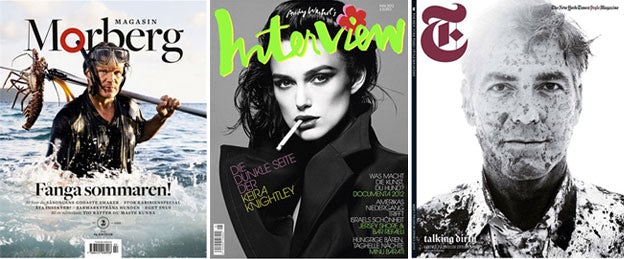
Left to right: Morberg (via Me and My Magazines); Interview (via Creative Bloq); The New York Times Magazine (via Pinterest)
The ground of nearly magazine covers is going to be either a photograph or an illustration. Either way, appealing images tend to have a expert corporeality of contrast betwixt light and nighttime regions. Apparently, for text to be readable, information technology must be calorie-free and set against a dark groundwork or vice versa.
So, much of magazine encompass pattern is finding a suitable spot for text — look at how New York Times Mode magazine below places the phrase "talking dirty" in the one region of George Clooney's shirt that is most blackened, or how the text over Keira Knightley on Interview magazine follows the line of her nighttime coat.
Conveniently, modern designers accept access to editing software like Photoshop, and so digitally lightening or darkening areas of a photograph is always a possibility. That crashing moving ridge in the foreground of the Morberg magazine page is a great bed for dark text spelling out the magazine's contents only it may non be a "natural" part of the epitome. The designer could take lightened it upward or even planted it there birthday! If done well, we'd never know.
2. Match and complement text color
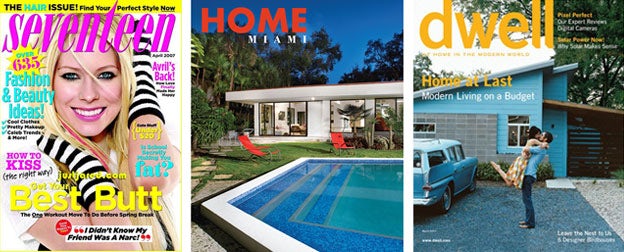
Left to correct: Seventeen Magazine (via naldzgraphics); Home Miami (via You the Designer); Dwell Magazine
Blackness and white are always solid choices for subtitles or other smaller text, simply a magazine cover's bigger, bolder text elements are a great place to inject some serious colour.
As any skilled designer knows, selecting colour is never random. In magazine cover design, common approaches are to either friction match or complement sure vivid areas of the photograph or illustration beneath. The below issue of Dwelling house Miami, for example, samples the vibrant scarlet tone from the patio chairs, only equally the outcome of Seventeen magazine samples the pink colour of Avril Lavigne'due south lipstick. Dwell, on the other hand, picks an orange that is not present in the photo, just which nicely complements the image'due south ascendant blue and feel tones.
3. Use 3D text behind and in front of the image

Left to right: Vanity Fair (via You the Designer); New York Magazine (via Behance); Rolling Stone (via Gossip Teen)
The mag encompass may literally be apartment but that doesn't mean all of the design elements have to share a single plane. Indeed, ane mutual arroyo is to place a photo or analogy and so it partly obscures some text while appearing backside other text, effectively setting up three layered planes.
Vanity Fair employs this approach in its cover with Tina Fey, and Rolling Rock really goes all out with its cover featuring Taylor Swift — she almost entirely blocks the title text! Detect how in the cover of New York magazine, the illustration of the earphone begins to wrap effectually the letter "k."
4. Placing emphasis with backgrounds, bolds, italics, etc.

Left to right: Wired (coverjunkie); Pop Mechanics (coverjunkie); Cosmopolitan
I of the main functions of the mag cover is to sell the event'south inside stories. This oftentimes means a lot of short teaser lines floating nearly the embrace page. The more of these in that location are, the more than methods a designer must come up with to depict the reader'due south eye to each — especially in popular magazines, which typically go for a loud arroyo.
On the most obvious level, bold and italic fonts are your all-time friend. From there, yous tin can get fancy with colored or shaped backgrounds — check out the pink and yellow strips on Wired's cover, and the highlighting and blue serrated ribbon on Popular Mechanics. Cosmopolitan, every bit you can run into, takes an everything-just-the-kitchen-sink approach.
v. Combining photography and drawing
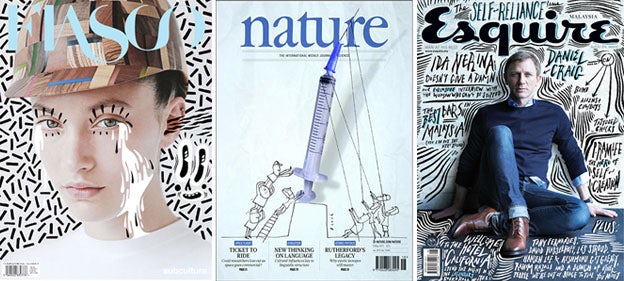
Left to right: Fiasco (via Creative Bloq); Nature (via coverjunkie); Esquire (via McMurry)
Harkening back to the humble putter, a combination of photographic and illustrated/designed elements is oftentimes a great mode to make a cover stand out. Check out the clever ways in which Fiasco magazine and Nature mag blend the worlds of analogy and photography, and how Esquire Malaysia surrounds Daniel Craig with hand-written text in place of typical typographic fonts
half-dozen. Accept illustration and digital design all the way
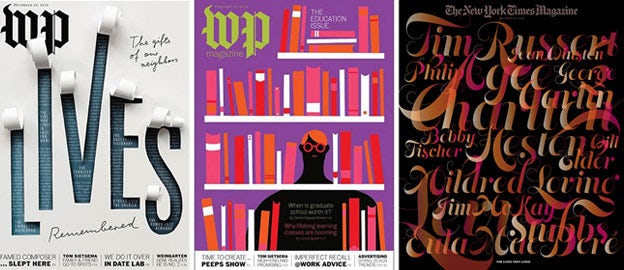
Left to correct: WP (via Pinterest); WP (via Graphic Art News); The New York Times Mag (via You the Designer)
Although less mutual than the photograph-axial approach, information technology's possible to pull off an engaging illustrated or typographic-just cover. Skilful colour and a unique fashion are, of course, key hither.
7. Spice upwards the deadening stuff
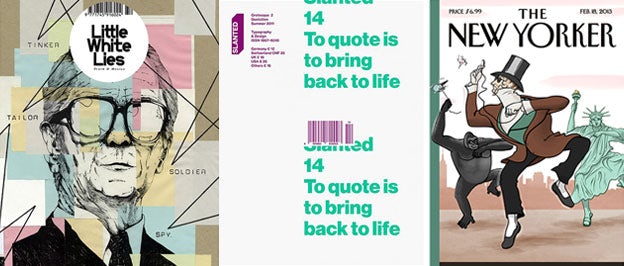
Left to correct: Little White Lies; Slanted (via coverjunkie); The New Yorker
These three elements, although perhaps not of much involvement to about designers, practice need to exist placed still. Most magazines take a pretty hands off approach, leaving them in a conventional spot in the bottom left corner. Some magazines, still, have found unique places to put them, making them striking pattern elements in themselves.
For example, see how The New Yorker includes the price and date to a higher place the championship line, in the archetype New Yorker font, or how Little White Lies always includes the barcode front and center in the centered round window. This particular upshot of Slanted is laid out to look similar a printing error, with the result being that the barcode, here in purple, sits dead center.
eight. Consistency is key

Conclusion
While all of the higher up techniques requite a designer plenty of room to get creative, it is ultimately important to remember that every regular publication needs some degree of consistency from issue-to-issue, in society to go on its branding intact.
This does not mean a template (although some publications seem to adhere to one), only it does mean that the overall layout and experience remain more or less constant. Cheque out these screen grabs of Cosmopolitan, Dwell, and Fourth dimension magazine covers to run into what we hateful.
0 Response to "Cool Fashion Catalog Front Page Ideas"
Post a Comment